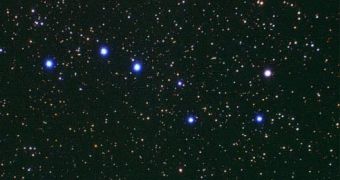It is the most recognizable group of bright stars on the night sky, thus not even novices can miss it. Anyone living northwards of the 41 parallel can enjoy it throughout the whole year. Most call it the Big Dipper, while to Irish people it is known as 'King David's Chariot'. The French call it the 'Great Chariot' and the British 'The Plough'. However, the name is not important, but the fact the with a little bit of astronomy, the Big Dipper can help you locate the North Star, Polaris or the North Celestial Pole.
This is done by locating the two outermost stars in the Dipper's 'handle', Dubhe and Merak. These two point directly towards the Polaris star. All one has to do is draw a line extending five times the apparent distance between the two stars towards the outer most star in the 'handle' of the Little Dipper. The particular star is Polaris.
However, the Big Dipper is no use to people living in the southern hemisphere of the planet. Instead they use the Southern Cross, in the Crux constellation to guide themselves. The Southern Cross as a group of four bright stars, of which Acrux and Becrux are of first magnitude, disposed in a formation resembling a cross. It has an apparent size just a little taller than that of the distance between the Dubhe and Merak stars of the Big Dipper or six degrees on the night sky.
The Cross
The Southern Cross presents great importance to residents of the southern hemisphere because it can help the South Celestial Pole. The problem is that unlike the Northern Celestial Pole, the south one is not marked by any bright stars. You can locate it nonetheless by drawing an imaginary line four times longer than the apparent size of the Cross in the direction of the longest bar. If you find an empty patch of sky, you've probably spotted it.
Although the Southern Cross is now available for observation only in the southern hemisphere, some 5000 years ago, it could be viewed from the northern regions as well. Two thousand years ago, the Southern Cross could be seen just above the horizon of Jerusalem - coinciding with the time when Jesus was crucified. Exactly south and east of the Cross, lies a black spot shaped into a pear in the Milky Way galaxy.
The feature is called the 'Coalsack', and is represented by a massive cloud of gas in our galaxy which is absorbing the light coming from stars located on its other side.
The best time to view both the Cross and the Big Dipper is in late May and Early June, when they occupy high positions in the sky. Residents of the Northern Hemisphere have to go at a latitude of at least 25 degrees south to see the Cross, while the Big Dipper is viewed entirely from the Southern Hemisphere from 25 degrees north.

 14 DAY TRIAL //
14 DAY TRIAL // 
